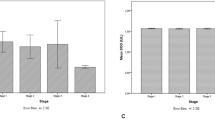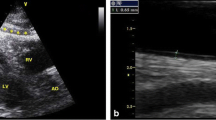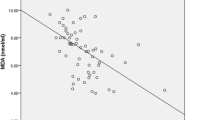Abstract
Behcet’s disease (BD) is a chronic, progressive disorder that affects many systems of the body including the eye. The aim of this study was to examine the effects of nitric oxide synthase activity (NOS), nitric oxide \(\left( {{\text{NO}}^ \bullet } \right)\), and homocysteine (Hcy) levels in patients with active BD. Included in this study were 18 male BD patients and 16 male healthy volunteers as controls. Erythrocyte NOS activity, \(\left( {{\text{NO}}^ \bullet } \right)\), erythrocyte sedimentation rate, serum C-reactive protein, and plasma Hcy values in the patients with BD were significantly higher than those of the control group. Our results show that these parameters play a major role in the inflammatory reactions observed in BD.

Similar content being viewed by others
References
Behcet H (1937) Uber residivietende apththose, durch ein virus verursachte geschwura am mund, am auge und an den genitalien. Dermatol Wochenschr 105:1152–1157
Taysi S, Demircan B, Akdeniz N, Atasoy M, Sari RA (2007) Oxidant/antioxidant status in men with Behcet’s disease. Clin Rheumatol 26:418–422
Taysi S, Kocer I, Memisogullari R, Kiziltunc A (2002) Serum oxidant/antioxidant status in patients with Behcet’s disease. Ann Clin Lab Sci 32:377–382
Watanabe K, Ohashi Y (1984) Natural killer cell activity in patients with Behcet’s disease. Am J Ophthalmol 98:813–814
Sakane T, Takeno M, Suzuki N, Inaba G (1999) Behcet’s disease. N Engl J Med 341:1284–1291
Nussenblatt RBWS, Palestine AG (1996) Uveitis: fundamentals and clinical practice. Mosby, St. Louis, pp 334–353
El-Ageb EM, Al-Maini MH, Al-Shukaily AK, Al-Farsi Y, Richens ER (2002) Clinical features of Behcet’s disease in patients in the Sultanate of Oman; the significance of antiphospholipid antibodies? Rheumatol Int 21:176–181
Aktan B, Taysi S, Gumustekin K, Bakan N, Sutbeyaz Y (2003) Evaluation of oxidative stress in erythrocytes of guinea pigs with experimental otitis media and effusion. Ann Clin Lab Sci 33:232–236
Memisogullari R, Taysi S, Bakan E, Capoglu I (2003) Antioxidant status and lipid peroxidation in type II diabetes mellitus. Cell Biochem Funct 21:291–296
Taysi S, Gul M, Sari RA, Akcay F, Bakan N (2002) Serum oxidant/antioxidant status of patients with systemic lupus erythematosus. Clin Chem Lab Med 40:684–688
Akkus I, Kalak S, Vural H, Caglayan O, Menekse E, Can G, Durmus B (1996) Leukocyte lipid peroxidation, superoxide dismutase, glutathione peroxidase and serum and leukocyte vitamin C levels of patients with type II diabetes mellitus. Clin Chim Acta 244:221–227
Taysi S, Polat F, Gul M, Sari RA, Bakan E (2002) Lipid peroxidation, some extracellular antioxidants, and antioxidant enzymes in serum of patients with rheumatoid arthritis. Rheumatol Int 21:200–204
Ezirmik N, Taysi S, Celik R, Celik G, Alici HA, Turhan H, Cesur M, Keskin D (2008) Oxidant/antioxidant status in pneumatic tourniquet-induced ischemia-reperfusion in meniscal patients undergoing arthroscopy. Asian J Chem 20:1950–1956
Maeda H, Akaike T (1998) Nitric oxide and oxygen radicals in infection, inflammation, and cancer. Biochemistry (Mosc) 63:854–865
Bakan E, Taysi S, Polat MF, Dalga S, Umudum Z, Bakan N, Gumus M (2002) Nitric oxide levels and lipid peroxidation in plasma of patients with gastric cancer. Jpn J Clin Oncol 32:162–166
Yildiz M, Taysi S, Umudum Z (2008) Nitric oxide synthase activity in erythrocyte of the rabbits which implanted composite resin filling materials into connective tissue. Asian J Chem 20:3902–3906
Vazgiourakis V, Sidiropoulos P, Bertsias G, Koutsounaki E, Fragouli E, Raptopoulou A, Kritikos H, Boumpas DT, Goulielmos GN (2007) Association of the nitric oxide synthase (eNOS) gene polymorphism with increased risk for both lupus glomerulonephritis and rheumatoid arthritis in a single genetically homogeneous population. Lupus 16(11):867–874
Rasmussen K, Moller J (2000) Total homocysteine measurement in clinical practice. Ann Clin Biochem 37:627–648
Undas A, Brozek J, Szczeklik A (2005) Homocysteine and thrombosis: from basic science to clinical evidence. Thromb Haemost 94:907–915
Ozkan Y, Yardim-Akaydin S, Sepici A, Engin B, Sepici V, Simsek B (2007) Assessment of homocysteine, neopterin and nitric oxide levels in Behcet’s disease. Clin Chem Lab Med 45:73–77
van Guldener C, Stehouwer CD (2000) Hyperhomocysteinemia, vascular pathology, and endothelial dysfunction. Semin Thromb Hemost 26:281–289
Weiss N (2005) Mechanisms of increased vascular oxidant stress in hyperhomocysteinemia and its impact on endothelial function. Curr Drug Metab 6:27–36
International Study Group for Behçet’s Disease (1990) Criteria for diagnosis of Behçet’s disease. Lancet 335:1078–1080
Durak I, Ozturk HS, Elgun S, Cimen MY, Yalcin S (2001) Erythrocyte nitric oxide metabolism in patients with chronic renal failure. Clin Nephrol 55:460–464
Moshage H, Kok B, Huizenga JR, Jansen PL (1995) Nitrite and nitrate determinations in plasma: a critical evaluation. Clin Chem 41:892–896
Kose K, Yazici C, Assioglu O (2001) The evaluation of lipid peroxidation and adenosine deaminase activity in patients with Behcet’s disease. Clin Biochem 34:125–129
Kose K, Dogan P, Ascioglu M, Erkilic K, Ascioglu O (1995) Oxidative stress and antioxidant defenses in plasma of patients with Behcet’s disease. Tohoku J Exp Med 176:239–248
Demirbag R, Yilmaz R, Guzel S, Celik H, Kocyigit A, Ozcan E (2006) Effects of treadmill exercise test on oxidative/antioxidative parameters and DNA damage. Anadolu Kardiyol Derg 6:135–140
Mangoni AA, Jackson SH (2002) Homocysteine and cardiovascular disease: current evidence and future prospects. Am J Med 112:556–565
Alvarez-Maqueda M, El Bekay R, Monteseirin J, Alba G, Chacon P, Vega A, Santa Maria C, Tejedo JR, Martin-Nieto J, Bedoya FJ, Pintado E, Sobrino F (2004) Homocysteine enhances superoxide anion release and NADPH oxidase assembly by human neutrophils. Effects on MAPK activation and neutrophil migration. Atherosclerosis 172:229–238
Boushey CJ, Beresford SA, Omenn GS, Motulsky AG (1995) A quantitative assessment of plasma homocysteine as a risk factor for vascular disease. Probable benefits of increasing folic acid intakes. JAMA 274:1049–1057
Loscalzo J (1996) The oxidant stress of hyperhomocyst(e)inemia. J Clin Invest 98:5–7
Wu LL, Wu JT (2002) Hyperhomocysteinemia is a risk factor for cancer and a new potential tumor marker. Clin Chim Acta 322:21–28
Stolzenberg-Solomon RZ, Albanes D, Nieto FJ, Hartman TJ, Tangrea JA, Rautalahti M, Sehlub J, Virtamo J, Taylor PR (1999) Pancreatic cancer risk and nutrition-related methyl-group availability indicators in male smokers. J Natl Cancer Inst 91:535–541
Feki M, Houman H, Ghannouchi M, Smiti-Khanfir M, Hamzaoui K, El Matri L, Mebazaa A, Kaabachi N (2004) Hyperhomocysteinaemia is associated with uveitis but not with deep venous thrombosis in Behcet’s disease. Clin Chem Lab Med 42:1417–1423
Calikoglu E, Oztas M, Sengul N, Adam B, Gurer MA (2002) Serum homocysteine level in Behcet’s disease. Haematologia (Budap) 32:219–224
Kiraz S, Ertenli I, Calguneri M, Ozturk MA, Haznedaroglu IC, Altun B, Erman M, Celik I (2001) Interactions of nitric oxide and superoxide dismutase in Behcet’s disease. Clin Exp Rheumatol 19:S25–S29
Akdeniz N, Esrefoglu M, Keles MS, Karakuzu A, Atasoy M (2004) Serum interleukin-2, interleukin-6, tumour necrosis factor-alpha and nitric oxide levels in patients with Behcet’s disease. Ann Acad Med Singapore 33:596–599
Orem A, Vanizor B, Cimsit G, Kiran E, Deger O, Malkoc M (1999) Decreased nitric oxide production in patients with Behcet’s disease. Dermatol 198:33–36
Buldanlioglu S, Turkmen S, Ayabakan HB, Yenice N, Vardar M, Dogan S, Mercan E (2005) Nitric oxide, lipid peroxidation and antioxidant defence system in patients with active or inactive Behcet's disease. Br J Dermatol 153:526–530
Aktan B, Taysi S, Gumustekin K, Ucuncu H, Memisogullari R, Save K, Bakan N (2003) Effect of macrolide antibiotics on nitric oxide synthase and xanthine oxidase activities, and malondialdehyde level in erythrocyte of the guinea pigs with experimental otitis media with effusion. Pol J Pharmacol 55:1105–1110
Bakan N, Taysi S, Yilmaz O, Bakan E, Kuskay S, Uzun N, Gundogdu M (2003) Glutathione peroxidase, glutathione reductase, Cu–Zn superoxide dismutase activities, glutathione, nitric oxide, and malondialdehyde concentrations in serum of patients with chronic lymphocytic leukemia. Clin Chim Acta 338:143–149
Disclosures
The authors certify that they have no financial interests such as employment, stock ownership, honoraria, paid expert testimony, as well as any personal relationships, academic competition, and intellectual passion which may inappropriately influence their actions. We have had full access to all the data in the study (if applicable) and thereby accept full responsibility for the integrity of the data and the accuracy of the data analysis. We ensure that there are no conflicts of interest (both personal and institutional) regarding specific financial interests that are relevant to the work conducted or reported in this manuscript.
Author information
Authors and Affiliations
Corresponding author
Rights and permissions
About this article
Cite this article
Taysi, S., Sari, R.A., Dursun, H. et al. Evaluation of nitric oxide synthase activity, nitric oxide, and homocysteine levels in patients with active Behcet’s disease. Clin Rheumatol 27, 1529–1534 (2008). https://doi.org/10.1007/s10067-008-0963-4
Received:
Revised:
Accepted:
Published:
Issue Date:
DOI: https://doi.org/10.1007/s10067-008-0963-4




